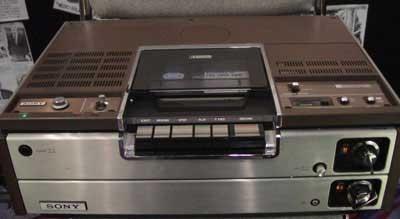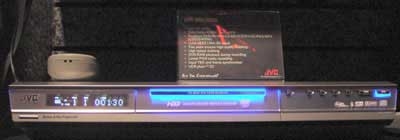CES04 Live: Higher-Tech DVD

The first piece of A/V equipment you encounter after passing through security and entering the main hall of the CES is decidedly not high-tech. It's a venerable Sony Betamax videocassette recorder so ancient that it still has channel-selector dials, as in "Don't touch that dial." The Home Recording Rights Coalition (www.hrrc.org) put it on display in its prominently located booth to commemorate the 20th anniversary of the Betamax case, in which Hollywood studios sued to block sales of the first VCR on grounds of copyright infringement. The case ended with a January 17, 1984 U.S. Supreme Court decision that made home video recording safe in the U.S. - and consequently enabled VCRs to help propel the consumer-electronics industry to record growth. (Not so incidentally, videotapes also made billions for the movie studios.) An ancient Sony Betamax VCR on display at the Home Recording Rights Coalition's booth to commemorate the January 1984 U.S. Supreme Court decision in the Betamax case, which established Americans' right to tape programs off the air and to dub other recordings "for personal use."
The Betamax deck is there to remind show-goers and the press that home recording rights are again under attack today by the same forces. One of the most important issues facing the HRRC and the industry in the months ahead relates directly to the coming high-definition DVD systems. Specifically, the HRRC is concerned that the FCC will allow "downresolution" - the deliberate softening of picture detail - of HDTV programs as a copy-protection method. This technique could cut the pixel resolution of HDTV-compatible component-video outputs by some 75% - bad news for high-definition DVD recorders.
Standard-def DVD Decks FlourishThankfully free from such worries are the standard-definition DVD recorders introduced by practically everybody and his Chinese uncle at this show. This CES will be remembered as the breakthrough show for DVD recording on several counts: the large number of models soon to be available, the substantial lowering of prices from last year's levels, and the variety of combo models available, especially those using hard-disk drives as a recording adjunct (a combination we've long advocated).
Panasonic was like many other manufacturers in introducing models at various prices, starting with the basic $450 DMR-E55; building up through the $550 DMR-E65, which adds an electronic program guide; and topping off with the $800 DMR-E85H, which has a 120-gigabyte (GB) hard-disk drive. All these Panasonic recorders, along with the $600 DMR-V75V DVD/VHS combo, record on both DVD-RAM and DVD-R/RW discs.
Pioneer, basking in the success of its combination TiVo/DVD recorders (Pioneer has exclusive rights for a year to this particularly felicitous combination), introduced only two new DVD recorders, both DVD-R/RW designs. The DVR-510H-S uses its 80-GB hard drive to facilitate high-speed dubbing to keeper DVDs. A 1-hour program can be zapped onto a 4x DVD-R blank in only 2 1/2 minutes! Pioneer also introduced its first "basic" model, the DVR-310S (prices to be determined).  Pioneer's DVR-510H-S records on DVD-R/RW discs and on an 80-GB hard drive. You can dub a 1-hour program from the hard drive to a DVD at high speed in only 2 1/2 minutes! (Price to be determined.)
Pioneer's DVR-510H-S records on DVD-R/RW discs and on an 80-GB hard drive. You can dub a 1-hour program from the hard drive to a DVD at high speed in only 2 1/2 minutes! (Price to be determined.)
JVC, in a fascinating and possibly visually significant development, uses the 160-GB hard drive in its $999 DR-MH30SL to perform what is essentially "two-pass" MPEG encoding when copying material from the drive to a DVD-RAM, DVD-R, or DVD-RW disc. (The deck can also play, but not record, DVD+R/RW discs.) It works like this: You record in a high-quality mode to the hard drive, at which time the system monitors and memorizes the amount of movement in the image. When you subsequently copy the material from the hard drive to a DVD, the recorder uses this information to optimize the DVD's MPEG encoding. The result is a much wider swing in DVD bit rate than usual for dubs from a hard drive, but in theory it should be more closely optimized to the changing requirements of the recorded image (like the similar bit-rate changes on commercial DVDs). The technique may lead to better overall reproduction in the lower-bit-rate (4-hour and higher) recording modes. I can't wait to test it out for myself.  The JVC DR-MH30SL DVD-RAM and DVD-R/RW recorder ($999) includes a 160-GB hard drive. When you record a program to the hard drive, it monitors the amount of movement in the image, and then when you dub it to DVD, it continually adjusts the bit rate to optimize the picture quality.
The JVC DR-MH30SL DVD-RAM and DVD-R/RW recorder ($999) includes a 160-GB hard drive. When you record a program to the hard drive, it monitors the amount of movement in the image, and then when you dub it to DVD, it continually adjusts the bit rate to optimize the picture quality.
More on Blu-ray High-def DVDsRaising the bit rate overall is what the rapidly approaching high-definition DVD systems are all about. Making a particularly strong showing at CES 2004 was the Blu-ray system, whose principal advocates include Sony, Philips, JVC, Pioneer, Panasonic, Mitsubishi, Thomson and other consumer-electronics giants as well as computer heavyweights Dell and Hewlett-Packard, the latter announcing their support at a Blu-ray tutorial press event. Speakers at this event repeatedly stressed that the new system is a substantial break with the standard DVD, not an incremental improvement. According to the technical specs, for example, the internal structure of the disc looks much more like a CD than the two bonded halves of a DVD. But with Blu-ray, the laser shines through the protective layer, which on a CD is where the label is printed (technical specs are available at www.blu-raydisc-official.org).  Sony's rather plainly styled prototype Blu-ray player with a test pressing of a prerecorded Blu-ray title.
Sony's rather plainly styled prototype Blu-ray player with a test pressing of a prerecorded Blu-ray title.
While previous Blu-ray demonstrations I've seen have emphasized the system's high-definition recording capabilities, this year - in a sign that the system is about ready to go commercial - there were playback demonstrations using prerecorded Blu-ray discs, the kind the system's advocates hope that studios will use to release movies. Several manufacturers showed prototype Blu-ray players, and since initially the system will be on the pricey side for both players and recorders, as well as blank and prerecorded discs, at least some of the industrial designers felt free to avoid the sameness in appearance that has already beset standard-definition DVD recorders. While Sony's player was pretty staid, JVC's model was striking in its simplicity. Pioneer, on the other hand, went completely crazy with its prototype.  JVC's Blu-ray prototype is striking in its simplicity.
JVC's Blu-ray prototype is striking in its simplicity.
And speaking of crazy, several of my press colleagues had that thought when LG Electronics - a major Korean manufacturer making a big push into the American market with this CES - announced that it would introduce a Blu-ray recorder (the LGXBF420) in the third quarter of this year! This despite the lack of movie-studio support for prerecorded titles, at least so far, the scarcity of broadcast HDTV programming worthy of preservation on recordable Blu-ray discs, the lack of widespread availability of blanks, and the potential for picture-smearing downresolution that the HRRC is concerned about. When and if it does hit these shores, LG's Blu-ray recorder will contain a 200-GB hard drive and built in HDTV and standard-TV tuners. No price has been set, but you can bet that it'll be high.  Pioneer went to the opposite extreme with its Blu-ray entry. Reminds me of Shelob from The Return of the King.
Pioneer went to the opposite extreme with its Blu-ray entry. Reminds me of Shelob from The Return of the King.
Alternative FormatsJust as with standard-def recordable DVD, several systems are trying to establish themselves as the high-definition DVD standard. (The older recordable-DVD battle evidenced itself at this show with competing claims for dual-layer recording in the DVD-R/RW and DVD+R/RW formats.) If more than one high-definition DVD system comes to market, the battle will actually be worse than with standard recordable DVDs since the movie companies will have to get involved.
The other system using a blue laser is the NEC/Toshiba HD DVD. Its main claim to fame is that HD DVD players will also be able to play standard DVDs thanks to their use of a single-lens, dual red/blue laser optical pickup. The Blu-ray players/recorders I've seen can only play Blu-ray discs. The cross section of an HD DVD pressing resembles that of a standard DVD much more closely than a Blu-ray disc, further enhancing compatibility. Toshiba had an HD DVD machine running at the show, and its images looked just fine, as did those in all the other high-definition DVD demonstrations I saw.
They included demonstrations of what is perhaps the most widely "compatible" format, a system developed by Microsoft and proposed by it as a standard to the DVD Forum (the DVD standards-making body). The centerpiece is the use of Microsoft's Windows Media Video HD (WMV HD) video and audio encoding systems. Bill Gates himself announced the availability of new titles (mostly Imax movies) in the format, which initially had exposure last year in a bonus disc with a special edition of Terminator 2. The great attraction of the Microsoft proposal is that neither the disc structure nor the player hardware has to be modified except for the addition of a WMV HD decoder function (that's how Bill gets paid, you see). Extra-savvy consumers with advanced camcorders could potentially roll their own WMV HD discs using new authoring tools announced by Sonic Solutions and Microsoft.
Microsoft is aggressively pursuing Hollywood for release of material in the WMV HD format, which it claims is well copy protected. I received copies of two new discs in the format and am looking forward to playing them when I get home to a computer with enough processing power. A 2.4-GHz Pentium PC is the minimum - Mac users are out of luck for the moment. < < Back to the International CES 2004 index
- Log in or register to post comments





























































